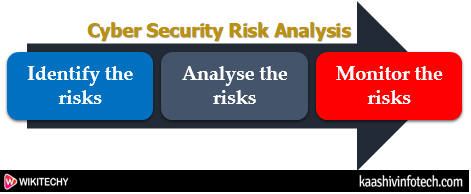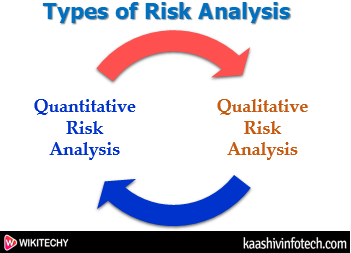Cyber Security Risk Analysis
Cyber Security Risk Analysis

Cyber Security Risk Analysis
- Risk analysis refers to the review of risks related to the actual action or event. The risk analysis is applied to information technology, projects, security issues and the other event where risks could also be analysed based on a quantitative and qualitative basis.
Enterprise and organization used Risk Analysis
- To anticipates and reduce the effect of harmful results occurred from adverse events.
- To plan for technology or breakdown or loss from adverse events, both natural and human-caused.
- To evaluate whether the potential risks of a project are balanced within the decision process when evaluating to move forward with the project.
- To identify the impact of and steel oneself against changes within the enterprise environment.
Benefits of risk analysis
Every organization must understand about the risks related to their information systems to effectively and efficiently protect their IT assets. Risk analysis can help a corporation to enhance their security in some ways . These are:
- Concerning financial and organizational impacts, it identifies, rate and compares the general impact of risks associated with the organization.
- It improves security policies and procedures also as develop cost-effective methods for implementing information security policies and procedures.
- It increases employee awareness about risks and security measures during the risk analysis process and understands the financial impacts of potential security risks.
Steps within the risk analysis process
The basic steps followed by a risk analysis process are:
Conduct a risk assessment survey
- Getting the input from management and department heads is critical to the risk assessment process. The risk assessment survey refers to start documenting the precise risks or threats within each department.
Identify the risks
- This step is employed to guage an IT system or other aspects of a corporation to spot the danger associated with software, hardware, data, and IT employees. It identifies the possible adverse events that would occur in a corporation like human error, flooding, fire, or earthquakes.
Analyse the risks
- Once the risks are evaluated and identified, the risk analysis process should analyse each risk which will occur, also as determine the results linked with each risk. It also determines how they could affect the objectives of an IT project.
Develop a risk management plan
- After analysis of the risk that gives a thought about which assets are valuable and which threats will probably affect the IT assets negatively, we might develop an idea for risk management to supply control recommendations which will be wont to mitigate, transfer, accept or avoid the danger .
Implement the danger management plan
- The primary goal of this step is to implement the measures to get rid of or reduce the analyses risks. we will remove or reduce the danger from starting with the very best priority and resolve or a minimum of mitigate each risk in order that it's not a threat.
Monitor the risks
- This step is liable for monitoring the safety risk on a daily basis for identifying, treating and managing risks that ought to be an important a part of any risk analysis process.
Types of Risk Analysis
The essential number of distinct approaches associated with risk analysis are:

Types Of Cyber Security Risk Analysis
Qualitative Risk Analysis
- The qualitative risk analysis process may be a project management technique that prioritizes risk on the project by assigning the probability and impact number. Probability are some things a risk event will occur whereas impact is that the significance of the results of a risk event.
- The objective of qualitative risk analysis is to assess and evaluate the characteristics of individually identified risk then prioritize them supported the agreed-upon characteristics.
- The assessing individual risk evaluates the probability that every risk will occur and effect on the project objectives. The categorizing risks will help in filtering them out.
- Qualitative analysis is used to work out the risk exposure of the project by multiplying the probability and impact.
Quantitative Risk Analysis
- The objectives of performing quantitative risk analysis process provide a numerical estimate of the general effect of risk on the project objectives.
- It is used to evaluate the likelihood of success in achieving the project objectives and to estimate contingency reserve, usually applicable for time and price.
- Quantitative analysis isn't mandatory, especially for smaller projects. Quantitative risk analysis helps in calculating estimates of overall project risk which is that the main focus.
